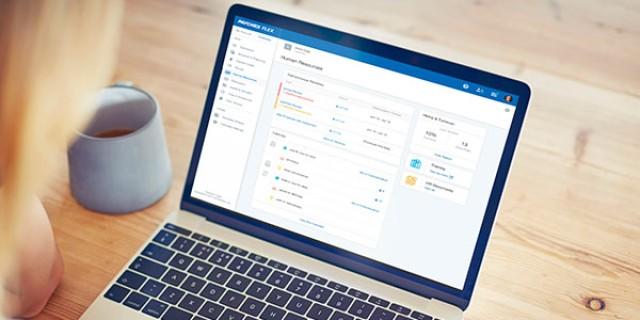- Beneficios para empleados
- Artículo
- Lectura de 6 minutos
- Last Updated: 09/23/2025
What Is the Health Insurance Marketplace & How Does It Work?

Table of Contents
Finding the right health insurance for employees shouldn't be complicated or costly. While traditional benefits packages with employer-subsidized health plans are common, the Health Insurance Marketplace is another option.
Beyond providing private group medical coverage, educating employees about the differences between private and public health insurance, especially the advantages of understanding what is marketplace health insurance, demonstrates your commitment to their well-being.
Keep in mind that applicable employers must provide written notice to new hires about the Health Insurance Marketplace, eligibility for premium tax credits, and how choosing a marketplace plan may affect their employer-provided benefits. This requirement stems from an amendment to the Fair Labor Standards Act (FLSA) introduced by the Affordable Care Act (ACA), commonly referred to as the "Notice of Coverage Options."
What Is the Health Insurance Marketplace?
The Health Insurance Marketplace, also known as the health coverage exchange or simply "the Marketplace," is an online platform created in 2010 under the Affordable Care Act (ACA). It's designed to help individuals — especially self-employed workers, gig workers, and those without access to employer-sponsored coverage – compare, shop for, and enroll in health plans that match their needs and budget.
As an employer, it's important to know that some states operate their own Marketplace (state-based exchange), while others rely on the federally run platform at HealthCare.gov. Both options offer the same core consumer protections, but enrollment dates, plan options, and support services may vary by state.
The Marketplace provides:
- A central location to compare qualified health insurance plans from participating insurers
- Side by side comparison of core features like benefits included, coverage details, cost-sharing (deductibles, co-pays), and required monthly premiums
- Access to government financial assistance, such as premium tax credits, to help lower employees' costs for coverage
Understanding which Marketplace serves your state ensures you can point employees to the correct place for information and enrollment and help them get the coverage and assistance they're eligible for.
What Is the Purpose of the Health Insurance Marketplace?
The Marketplace was created by the ACA to provide a way for all Americans to gain access to affordable health insurance. While many citizens get health insurance coverage through an employer, not everyone has this option. More and more individuals are turning to gig work, freelancing, or other income sources outside of the traditional employer/employee arrangement, making the Marketplace increasingly important for helping more people get access to health insurance.
What Benefits Are Included in the Health Insurance Marketplace?
All health insurance plans sold through the Health Insurance Marketplace must meet minimum requirements set by the ACA. Although these requirements can vary by state, they generally include:
- Coverage of preexisting medical conditions
- No annual or lifetime limits on covered benefits
- Out-of-pocket maximums to protect against high medical costs
- Pricing that meets "affordability" standards set by law
Most importantly, every Marketplace plan must cover these 10 essential health benefits (EHB):
| Essential Health Benefit | What It Means |
| Ambulatory patient services | Outpatient care you receive without hospital admission |
| Emergency services | Emergency room and urgent services |
| Hospitalization | Inpatient surgery and overnight hospital stays |
| Pregnancy, maternity, newborn care | Care before, during, and after childbirth |
| Mental health & substance use | Counseling, therapy, and addiction treatment |
| Prescription drugs | Medications prescribed by your doctor |
| Rehabilitative & habilitative | Services/devices to restore or improve abilities |
| Laboratory services | Lab tests and diagnostics |
| Preventive and wellness services | Routine checkups, screenings, and chronic disease management |
| Pediatric services | Health, dental, and vision care for children |
While these are the essential services required to qualify as a Marketplace plan, many plans offer additional benefits, such as managed care support for chronic diseases or dental and vision coverage for adults (though dental and vision is required of all Exchange plans for children under 18).
What Is the Difference Between the Marketplace and Private Insurance?
Private insurance, sometimes referred to as a private health exchange, is similar to the Marketplace in that several plan options can be easily compared through an online portal. These coverage options are typically offered through an insurance broker or a single private insurance company that offers multiple plan options for employers or individuals.
However, the plan options offered through a private exchange are not required to meet all of the standards set forth in the ACA. While many private health insurance plans do cover the 10 essential health benefits and meet other minimum standards of the ACA, there are also no government subsidies offered on plans issued through private health insurance exchanges.
What Is the Difference Between On-Exchange & Off-Exchange?
Once a plan meets the requirements set by the state where coverage will be provided, the plan is designated as a "Qualified Health Plan" (QHP), meaning it is qualified to be sold within the Health Insurance Marketplace. Since the Marketplace is also referred to as the Exchange, these QHPs are sold "on-exchange."
Health insurance plans sold to individuals or organizations outside of the government's public exchange are considered "off-exchange." Although these plans are not required to meet the same requirements as QHPs, they often do. In fact, many health insurance companies offer the same qualified health coverage off-exchange directly to employers through workplace benefits programs.
Here's what's crucial to understand about off-exchange insurance plans: they won't qualify for government subsidies, even if the coverage looks nearly identical to marketplace options. Only plans purchased through the official Health Insurance Marketplace come with premium tax credits or cost-sharing reductions. Encourage your employees to verify subsidy eligibility before choosing any health plan, as these savings can dramatically reduce monthly costs.
When Is Open Enrollment for the Health Insurance Marketplace?
Since the enactment of the ACA and the creation of the Health Insurance Exchange, the standard open enrollment period has typically run from Nov. 1 through Dec. 15 each year to enroll in health insurance coverage effective Jan. 1. Any state-run exchanges must meet the minimum open enrollment length, but they do have some flexibility to shift the start and end dates or even extend the length of the enrollment period for all state citizens. Be sure to check with your state-run exchange for the most accurate enrollment period dates.
Outside of the traditional open enrollment period, individuals can enroll in Marketplace plans if they experience certain qualifying life events:
- Loss of Health Coverage: Losing job-based, individual, or government insurance
- Family Changes: Marriage, divorce, birth/adoption, or death in the family
- Moving: Changing ZIP code or county, moving for school, work, or housing
- Other Qualifying Events: Income changes, citizenship, tribal membership, AmeriCorps service, release from incarceration
This special enrollment period typically lasts 60 days from the date of the qualifying event, allowing the individual to enroll in a new plan outside of open enrollment.
In addition to these situations, Healthcare.gov also allows special enrollment periods for complex issues, such as serious medical emergencies, natural disasters, technical errors when applying for coverage, or special cases like domestic abuse, court orders, or successful appeals.
How Do I Get Health Insurance on the Exchange?
Your employees can explore coverage options and enroll in a Marketplace plan by following these simple steps:
- Visit healthcare.gov/get-coverage and select your state from the drop-down menu. If your state has its own exchange, you'll be directed to the right site.
- Create an account and enter household details, income, and information about anyone needing coverage. The Marketplace will check if you qualify for financial assistance.
- Choose one or more plan options to compare coverage levels, co-pays, premium costs, and expected out-of-pocket costs.
- Choose the plan that fits your needs, enroll all eligible family members, and pay your monthly premium directly through the Marketplace or your insurance company.
When Is Open Enrollment for Individual Health Insurance
Since the enactment of the Affordable Care Act (ACA), individuals can no longer purchase health insurance at any time of year. Instead, most plans are only available during an annual Open Enrollment Period. For most states, Open Enrollment runs from Nov. 1 to Jan. 15 each year. Individuals must enroll by Dec. 15 for coverage to start on Jan. 1. If they enroll between Dec. 16 and Jan. 15, coverage will start Feb. 1.
However, some states operate their own health insurance exchanges, and the exact open enrollment deadlines can vary from state to state. Always confirm your state's dates to ensure your employees don't miss their chance to enroll. Outside of this window, employees may only sign up for or change plans if they experience a qualifying life event that makes them eligible for a Special Enrollment Period.
What Information Do I Need To Sign Up?
To create an account on the Exchange, you (or your employees) will need some basic personal information, such as name, email address, mailing address, and date of birth. Once the account is created, you may also be asked for the following types of information:
- Ages and relationships of any qualifying household members who may also need coverage
- Tobacco usage for any adults
- Household income
- Any special coverage (i.e., dental for adults) you would like included in your plan
This additional information is used to help your employees find the best plan to match their needs, but also to help identify any subsidies they may qualify for to help lower the cost of insurance coverage.
Who Can Buy Health Insurance on the Exchange?
Employees may be eligible to purchase individual health insurance plans on the Health Insurance Marketplace, even if group health insurance is available. To qualify, individuals must meet these minimum requirements:
- Live in the United States
- Be a U.S. citizen or have legal immigration status
- Not be currently incarcerated
- Not currently have Medicare coverage
Even if health care coverage is available through an employer, it may be beneficial for employees to explore the coverage options available through the Exchange. Households between 100% and 400% of the federal poverty level generally qualify for a premium subsidy, so sharing this information with your employees can be another way to help them secure affordable medical coverage. Additionally, recent legislation — such as the American Rescue Plan Act — has temporarily expanded subsidy eligibility beyond the 400% threshold, subject to specific conditions. This means some higher-income households may also benefit, depending on the circumstances.
State vs. Federal Marketplaces: What's the Difference?
Some states, such as California and New York, operate their own state-based health insurance exchanges, while others rely on the federal HealthCare.gov platform. Knowing whether your state uses a state or federal Marketplace helps you guide employees to the right enrollment process and deadlines. State exchanges often extend deadlines or offer additional enrollment windows. They may also feature different insurance companies or plan options compared to the federal site. However, all exchanges process the same government subsidies and provide identical consumer protections.
Provide the Best Health Benefit Options for Your Employees
Even if you offer robust benefit packages, there is no one-size-fits-all option that is perfect for every employee. You can provide the best options for your employees by sharing information on all of the enrollment options available to them, including the plans available through the public Health Insurance Marketplace. You can even make things easier for you and your employees by exploring employee benefits options available through Paychex.
Frequently Asked Questions About the Health Insurance Exchange
-
What Is the Difference Between Marketplace and Medicaid?
What Is the Difference Between Marketplace and Medicaid?
Marketplace plans are offered through government-run exchanges and provide ACA-compliant health insurance to eligible individuals and families. Medicaid is a state-run program that offers free or low-cost coverage based on income and other criteria.
-
Can Employees Use the Marketplace if They’re Offered Employer Coverage?
Can Employees Use the Marketplace if They’re Offered Employer Coverage?
Yes, employees may use the Marketplace, but they generally only qualify for subsidies if their employer's plan is considered unaffordable or doesn't meet minimum coverage standards as defined by the ACA. For employer coverage to be deemed unaffordable under the ACA, the employee's contributions must exceed a specific percentage of their household income — a threshold that is determined annually.
-
What’s the Income Limit for Marketplace Health Insurance?
What’s the Income Limit for Marketplace Health Insurance?
Marketplace health insurance doesn't require individuals to meet a specific income limit. But eligibility for premium subsidies typically applies to households earning between 100% and 400% of the federal poverty level. While coverage is broadly available, subsidy eligibility is based on federal poverty level guidelines and may change under specific legislative updates.
-
Marketplace vs. Exchange vs. ACA Plan: Are They the Same?
Marketplace vs. Exchange vs. ACA Plan: Are They the Same?
Yes — these terms are often used interchangeably. All refer to health plans that comply with the Affordable Care Act and are available through federal or state-run Marketplace exchanges.
-
What Should Employers Know About Marketplace Subsidies?
What Should Employers Know About Marketplace Subsidies?
Companies with 50 or more full-time equivalent workers must offer adequate, affordable health coverage — or pay penalties when employees seek marketplace subsidies instead.
Insurance sold and serviced by Paychex Insurance Agency, Inc., 225 Kenneth Drive, Rochester, NY 14623. CA License #0C28207
Learn More About Employee Benefits With Paychex
To learn more about how the Health Insurance Marketplace can help your business and employees, connect with Paychex for expert guidance and personalized support.
Tags








